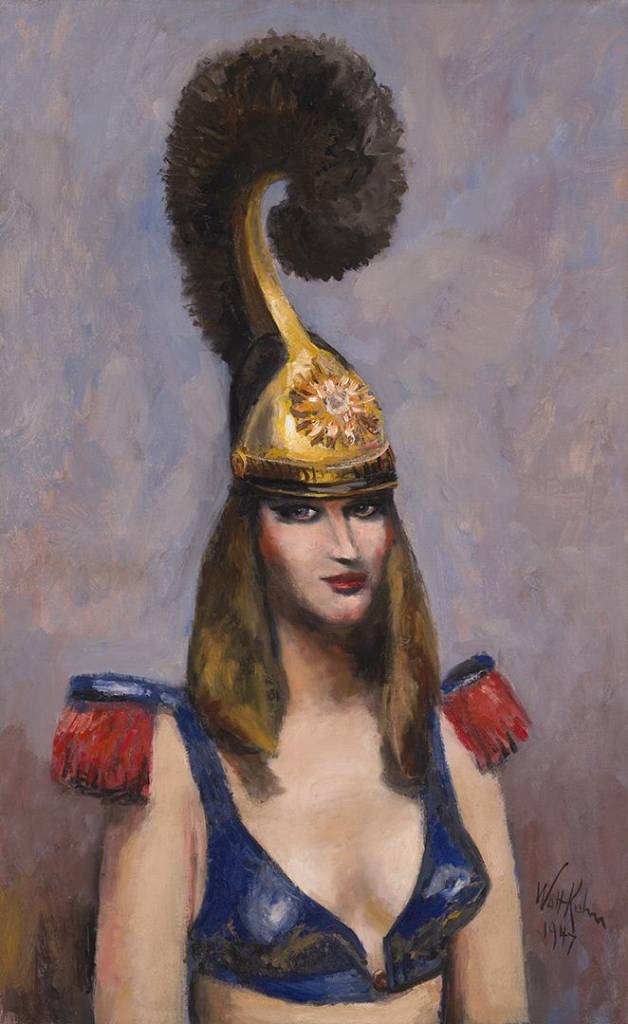Today we celebrate the birthday of artist Walt Kuhn and his uniquely American Modernist style. Highly influenced by the theater, Kuhn was not just an artist, but a costume designer, director, and a showman. Maybe you’ve already noticed and enjoyed Dragoon, a painting of a circus performer in a scanty costume and plumed helmet reminiscent of an officer’s uniform, which is featured in the Museum’s permanent collection. Now, Crystal Bridges is proud to showcase another painting by Kuhn: Plumes, on view in the temporary exhibition The Art of American Dance.
Walt Kuhn was introduced to the theater at an early age. His mother took him to circus performances and vaudeville shows. By the age of 17, he had a job selling costumes to performers at a sporting goods store, and throughout his life he maintained strong relationships with performers. He once said that he would rather sit in a dingy dressing room with a performer than eat caviar with the well-to-do; although truthfully, he got along well with both.

Models in Walt Kuhn’s studio.
Image from the Walt Kuhn family papers at the Archives of American Art, Smithsonian Institution
Performers made up the majority of his subjects. Kuhn felt that setting and mood were of utmost importance in his paintings, and so the costume, makeup, and poses of his subjects were tightly orchestrated. He and his wife even made some of the costumes themselves, sometimes turning non-performers into imaginary trapeze artists through the magic of imagination and illusion.
There is no doubt that Kuhn definitely felt an affinity for his subjects. But he was also using them to brand himself as a painter of the American identity. Kuhn called his subject “buckeye,” meaning that it was real, unvarnished, and even a little bit kitschy. His style was rooted in American Modernism, which meant that it was concerned with contemporary American subjects, flattened space, and moments of striking color on a palette of muted neutrals.

Walt Kuhn, 1904 or 1905
Archive of American Art, Smithsonian Institution
The originality of the subjects is also reflected in Kuhn’s big personality. His studio often looked like the dressing rooms of the performers he painted, all in a pleasant but chaotic disarray. Charismatic and opinionated, Kuhn worked as a theater professional in the early 1920s, and learned to tap dance. By some accounts, he even tapped and sang while he painted. But there was a darker side to Walt Kuhn too. He was often secretive, keeping different aspects of his life separate and compartmentalized. He really only began painting with vigor after a serious near-death experience in 1925, caused by an ulcer.
In Plumes, Kuhn portrays a female performer with voluminous white and black feathers in her headpiece, looking directly at the viewer with a solemn gaze, her shoulders slightly hunched forward, in a way that appears honest and unadorned, despite her magnificent costume. What is most revealing about this painting, however, may not be her expression or emotion, but the trust between artist and model, and the dignity in Kuhn’s depiction of her. It’s not just a painting that shows disillusionment, but also a painting that shows the artist’s empathy for his subject.
For more information on the role of performer’s such as those Kuhn painted, please come see The Art of American Dance, which will be on view from October 22 to January 16.
http://www.phillipscollection.org/research/american_art/artwork/Kuhn-Plumes.htm
http://www.artinamericamagazine.com/reviews/walter-kuhn/





